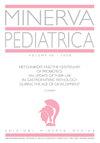寄养儿童的粮食安全和营养状况:保护脆弱人口的新视野。
IF 2.6
4区 医学
Q2 Medicine
引用次数: 0
摘要
关于寄养儿童的营养状况、集体之家日常菜单的质量以及这些组织内的食品安全的研究很少。因此,本研究的目的是调查他们。方法将来自7个集体之家(A组)的125名0-17岁儿童与来自普通人群(B组)的121名儿童进行比较。采用BMI百分位数评价营养状况。通过统计学分析比较两组的平均百分位数。每个组织的每日营养和热量分布均采用24小时召回法获得。实施了一份具体的问卷来评估粮食安全。结果从平均bmi年龄(或身高长度)百分位数的分析中,我们没有观察到A组和b组之间有统计学上的显著差异。除了蛋白质略有过量和多不饱和脂肪酸略有不足外,集体之家的平均每日营养和卡路里分布几乎是最佳的。此外,铁和钙的摄入量也很低。所有组织都获得了“高粮食安全”称号。结论寄养儿童的营养状况并不比普通人群儿童差。寄养为他们的成长提供了必要的条件。本文章由计算机程序翻译,如有差异,请以英文原文为准。
Food security and nutritional status of children in foster care: new horizons in the protection of a fragile population.
BACKGROUND
The nutritional status of foster children, the quality of daily menus in group homes and the food security inside these organizations have been poorly studied. For this reason, the aim of this study was to investigate them.
METHODS
A sample of 125 children, ranging in age from 0-17 years, among seven group homes (group A) was compared with 121 children of the general population (group B). To evaluate nutritional status, BMI percentiles were used. Mean percentiles of both groups were compared through statistical analysis. Both nutritional and caloric daily distributions in each organization were obtained using the 24-hour recall method. A specific questionnaire was administered to evaluate food security.
RESULTS
From the analysis of mean BMI-for-age (or height-for-length) percentiles, we did not observe statistically significant differences between group A and group B. The average daily nutrient and calorie distribution in group homes proves to be nearly optimal except for a slight excess in proteins and a slight deficiency in polyunsaturated fatty acids. Moreover, a low intake of iron and calcium was revealed. All organizations obtained a High Food Security profile.
CONCLUSIONS
Nutritional conditions of foster children are no worse than that of children of the general population. Foster care provides the necessary conditions to support their growth.
求助全文
通过发布文献求助,成功后即可免费获取论文全文。
去求助
来源期刊

Minerva pediatrica
PEDIATRICS-
CiteScore
2.70
自引率
3.80%
发文量
1
审稿时长
>12 weeks
期刊介绍:
Minerva Pediatrica publishes scientific papers on pediatrics, neonatology, adolescent medicine, child and adolescent psychiatry and pediatric surgery. Manuscripts may be submitted in the form of editorials, original articles, review articles, special articles, letters to the Editor and guidelines. The journal aims to provide its readers with papers of the highest quality and impact through a process of careful peer review and editorial work.
 求助内容:
求助内容: 应助结果提醒方式:
应助结果提醒方式:


